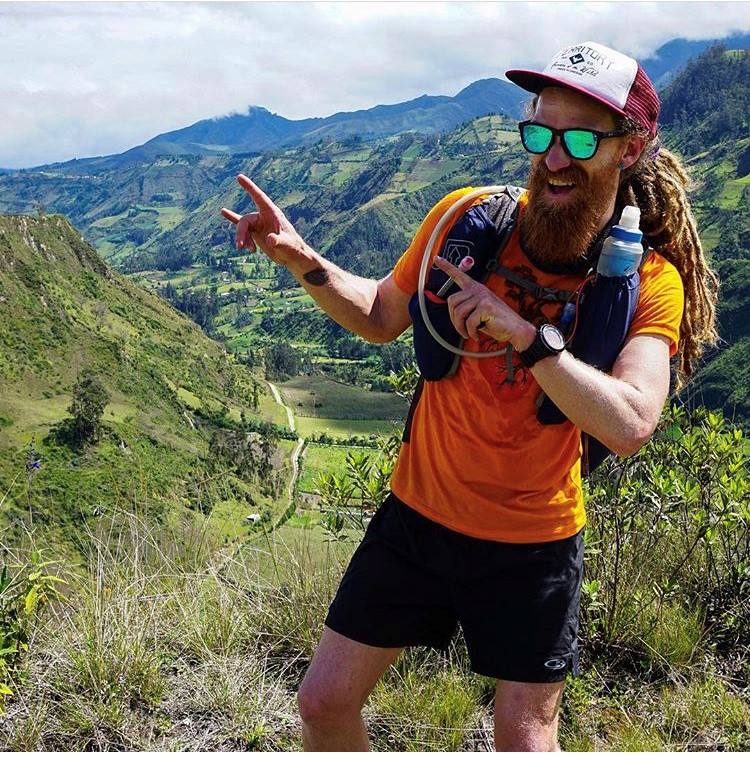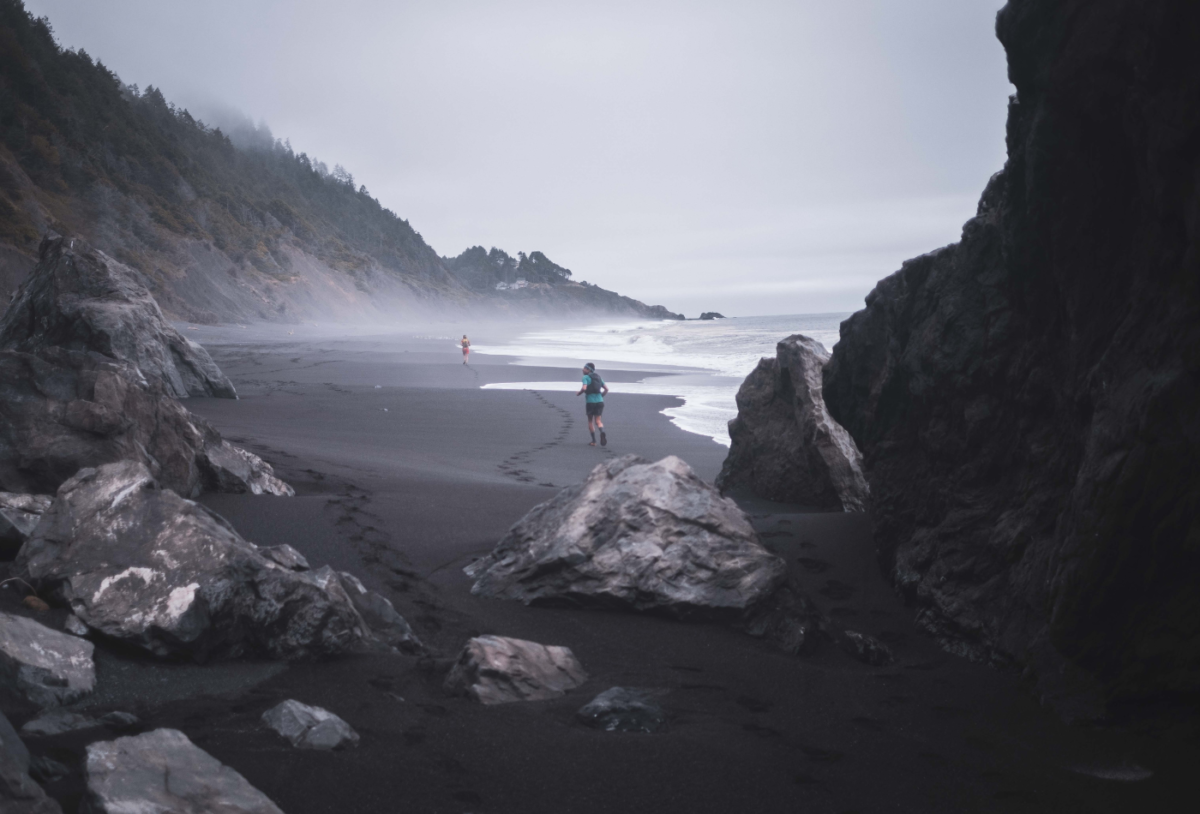Pacific Salmon have been an ecological cornerstone of the Pacific Northwest for millions of years. By studying their lifespans, a broader picture of connection between all of nature comes into focus. As runners travelling through these landscapes, we are invited to join these ebbs and flows. Jeff Mogavero explores these connections through the eyes of a wildlife technician and ultra-runner.
“And while they delight our senses, the salmon also represent us in a profound and heartfelt way. They are the precious mettle of our watersheds. They embody our home places. Salmon are the deep note of our dwelling here, the silver soul of this green bell-steelhead, sockeye, coho, chum, pinks, and kings.”
-Tom Jay, “Homecoming”

TO RUN the Lost Coast Trail is to flow between the earth and the sea. To scramble up stony bluffs and to trot across tan satiny acres of beach sand. To see more sea lions and elk than people. To deeply breathe in the tang of saltwater and marine life. To run the wildest edge of the west coast.
Over days, you’ll run across beaches of sand, beaches of volcanic rock, beaches of bowling-ball-sized rocks, beaches of cobble and seaweed. For those days, you’ll live in deepest relationship with the rhythm of the earth and sea, timing your movement around the tides, feeling those great shifts of the ocean around you. Waking to the crashing of waves and watching dusk fall around a campfire.
All the while running along the edge of the King Range, along the edge of the Sinkyone Wilderness, and most of all, along the edge of the great North Pacific. Standing awestruck above the cool plain of the sea, or flowing through marine meadows beside the water’s hypnotic boil. The sea’s mood different every hour and every day: wide, skidding waves or seething combers, or silky calm beneath a golden setting sun, or the slow pound against thousand foot cliffs on a foggy morning. And just as the weather strips the coastline, it strips you down and then builds you up, filling you with a wild strength you never knew you had.

To run the forgotten coast is also to run through the gateway of one of the world’s greatest ecological miracles:
This wild rib of forgotten coastline is the southernmost range of Pacific Salmon, a two-million-year-old magnificent species that is the ecological cornerstone of the entire north Pacific, from California up through Oregon, Washington, BC and Alaska, and even across to Siberia and Northern Japan. Salmon are born in the clear cold streams of these regions and migrate out to sea, returning two years later to the exact stream where they were born, fighting their way upstream to spawn, laying the eggs for the next generation, and then die.
When they go to sea for voyages that can be 10,000 miles long, they’re the size of your fist, and when they swim back up the exact alder-lined home creek where they were born twenty-four months later, they’re often the size of your leg, their flesh red from the mineral richness of the deep sea. As they spawn and die, they are eaten by eagles, bears and other creatures who spread their ocean-mineral-rich remains throughout the forest, even into the tops of trees. If you take a carbon scan of, say, a two-hundred foot Sitka Spruce or Doug Fir, you can literally see the salmon matter up in the crown of the tree. Thus, the lush Pacific Northwest temperate rainforest is a “Salmon Forest,” and much of its biological richness comes from the Salmon importing ocean nutrients inland into the forests, just as the dark, cool forests keep the salmon streams cold and clear for the salmon to thrive.

Generations ago, Salmon inhabited watersheds all the way down to San Diego and southern Japan, surviving and adapting to ice ages, floods and droughts. But in the last century, ecological pressure from development, mining, dredging, logging, and climate change has reduced their range. Along the Lost Coast, the Salmon runs have been kept alive by a team of dedicated watershed activists who have fought for decades to protect the ecological and hydrological integrity of salmon streams, and even hand-delivering smolts (baby fish) into healthy stream habitat. They’ve prevented dams, built fish ladders and hatcheries, protected and helped to hatch eggs, and restored the salmon runs on rivers like the Mattole and the Eel. The King Range Conservation Area, created in 1970, was the nation’s first designated Conservation Area, and a quarter-century later the coastal King Range Wilderness (that hosts much of the trail) was also designated to further protect this place. Offshore, the Rocks and Island Wilderness protects even more habitat. So, as you run beneath Ospreys and Cormorants, with seals barking and bear tracks visible in the sand, you are moving through one of the crown jewels of American conservation.

And so, to run the Lost Coast trail is to run through America’s longest stretch of undeveloped coastline outside of Alaska, in the remote footsteps of conservationists and activists who protected it. It is to marvel at herds of Elk while Bald Eagles fish the crumpling waves. To stagger up ragged thumbs of land, and to narrowly escape across tide flats before the ocean gushes back in. To be a participant in an ecosystem that stretches north across the Pacific all the way to Japan, in the soul-shadow of those extraordinary Salmon; and just as the Salmon return to their restored home streams bigger and stronger, we are restored by this wild ecological integrity, returning to some deep, quiet place within ourselves, strengthened and calmed. By living for a bit in the resonance of such a place, maybe we can return to our homeplaces deeper and more resilient. As salmon activist and author Freeman House has written of this coast, “I find in myself a new fluidity of response, a diminished sense of attachment, a more comfortable sense of humility. I am a different person than I was when I arrived in this valley.”

With three decades spent exploring the PNW and Alaska, Ian is based in Maine, where he directs the Kauffmann Program for Environmental Writing and Wilderness Exploration, and teaches writing, ecology, brain science, music and mindfulness to high school students. With over two decades leading trips and expeditions across the US, Alaska and internationally, he loves empowering people to take agency in their lives and discover new places. Ian is a poet and graduate of the Rainier Writing Workshop, and his writing has been featured in places like Terrain.org, Orion and High Desert Journal. He also directs a community steelband, loves kayaking big water, drinks copious amounts of coffee, geeks out around nutrition, literature and fitness, and was once a member of an Inuit Dance Troupe.
Check out his website at Ianramsey.net

Run this rugged stretch of California coast with Aspire and see how you come away changed.
Run the Lost Coast Trail.

